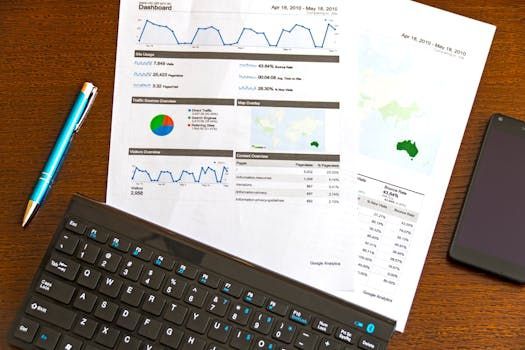Key Digital Marketing KPIs for St. Louis Businesses in 2025
Introduction: Why KPIs Matter for St. Louis Businesses
In today’s fast-paced digital world, businesses in St. Louis need to stay ahead of the curve by understanding their customers’ behaviors and preferences. With the rapid growth of digital platforms and evolving consumer habits, data-driven decision-making has become essential. Key Performance Indicators (KPIs) are the backbone of this process, helping businesses measure what matters most and make informed adjustments to their marketing strategies. For St. Louis businesses, these metrics are not just numbers—they’re actionable insights that can drive growth and improve return on investment (ROI).
By focusing on the right KPIs, St. Louis companies can align their marketing efforts with local market trends. Whether it’s attracting more foot traffic to a brick-and-mortar store or boosting online sales, understanding which metrics to track ensures resources are allocated effectively. As we move into 2025, leveraging these insights will be crucial for staying competitive in the region.
What Are Digital Marketing KPIs?
Digital marketing KPIs, or Key Performance Indicators, are measurable values that help businesses evaluate the success of their marketing campaigns. These metrics go beyond surface-level data to provide a clear picture of how well specific strategies are performing. For example, instead of just tracking the number of website visitors, KPIs dig deeper to analyze how those visitors engage with the site and whether they convert into leads or customers.
It’s important to distinguish between vanity metrics—like social media followers—and actionable KPIs that directly impact business goals. While vanity metrics might look impressive, they don’t always translate into tangible results. Actionable KPIs, on the other hand, focus on outcomes like lead generation, sales, and customer retention, making them invaluable for St. Louis businesses aiming to grow sustainably.
Website Traffic and Visitor Behavior Metrics
For any business operating online, website traffic is a critical indicator of performance. It serves as a digital storefront pulse, showing how many people are visiting your site and where they’re coming from. Key metrics such as sessions, unique users, traffic sources, bounce rate, and session duration provide valuable insights into visitor behavior. In St. Louis, understanding these metrics can help businesses tailor their content to better meet local audience needs.
However, interpreting these metrics requires context. A high bounce rate isn’t always negative; for instance, if visitors find the information they need quickly, they may leave satisfied. By analyzing traffic patterns and user intent, St. Louis businesses can refine their websites to improve engagement and conversion rates , ensuring their digital presence reflects the unique characteristics of the local market.
Conversion Rate and Lead Generation
Conversions are the ultimate goal of most digital marketing efforts, whether it’s completing a purchase, filling out a contact form, or signing up for a newsletter. Tracking both major conversions and micro-conversions is essential for understanding how effectively your campaigns are driving action. For St. Louis businesses, optimizing lead generation means tailoring strategies to resonate with the behaviors and preferences of local customers.
Micro-conversions, such as downloading a resource or subscribing to an email list, often serve as stepping stones toward larger goals. By monitoring these smaller actions, businesses can identify opportunities to nurture leads and guide them through the sales funnel. This approach not only boosts immediate results but also builds long-term relationships with St. Louis-area consumers.
Local Search and Google Business Profile Insights
For brick-and-mortar businesses in St. Louis, local search visibility is a game-changer. Monitoring keyword rankings for local terms , analyzing Google Business Profile insights, and tracking appearances in the map pack can significantly enhance foot traffic and brand awareness. These metrics highlight how easily potential customers can find your business when searching for products or services nearby.
St. Louis businesses should prioritize optimizing their Google Business Profile to ensure accurate information and positive reviews are readily available. By doing so, they can capitalize on local search trends and position themselves as top choices within the community. This strategy is especially effective for industries like retail, restaurants, and professional services that rely heavily on proximity-based marketing.
Campaign ROI and Cost-Per-Acquisition (CPA)
Measuring campaign ROI and CPA is vital for determining the financial effectiveness of digital marketing efforts. For St. Louis businesses investing in pay-per-click (PPC) ads or paid social media campaigns , understanding how much revenue each dollar spent generates is key to sustainable growth. Calculating true ROI involves attributing revenue back to specific campaigns and channels, ensuring every expense contributes to measurable outcomes.
In a competitive local advertising landscape, keeping CPA low while maintaining quality leads is a delicate balance. By regularly reviewing these metrics, St. Louis businesses can identify underperforming campaigns and reallocate budgets to higher-impact initiatives. This data-driven approach ensures marketing dollars are spent wisely, maximizing returns in a challenging market.
Social Media Engagement and Audience Growth
Social media platforms like Facebook, Instagram, LinkedIn , and emerging channels offer powerful opportunities for engaging with St. Louis audiences. Tracking likes, shares, comments, and follower growth provides insight into how well your content resonates with local users. These engagement metrics are particularly valuable because they directly influence referral traffic and, ultimately, business outcomes.
For St. Louis businesses, fostering authentic connections through social media can strengthen brand loyalty and drive word-of-mouth referrals. By analyzing which types of posts generate the most interaction, companies can refine their strategies to better align with audience interests. Additionally, monitoring social referral traffic helps quantify the impact of social media efforts on lead generation and sales.
Email Marketing Performance
Email marketing remains one of the most effective ways to nurture leads and maintain relationships with St. Louis customers. Key KPIs such as open rate, click-through rate, and unsubscribe rate reveal how well your emails perform and whether they resonate with recipients. By optimizing subject lines, personalizing content, and segmenting lists, businesses can improve these metrics and build stronger connections with their audience.
Customer Feedback and Online Reputation
Online reviews, survey responses, and direct feedback serve as critical KPIs for gauging customer satisfaction and trust. Positive reviews not only boost visibility in search results but also influence purchasing decisions among St. Louis consumers. Actively managing your online reputation ensures that your business maintains credibility and attracts new customers who value peer recommendations.
Cross-Channel Attribution and Integrated Data Reporting
To truly understand the customer journey, St. Louis businesses must integrate data from various sources, including website analytics, CRM systems, and point-of-sale (POS) platforms. Cross-channel attribution allows companies to see how different touchpoints contribute to conversions, providing a holistic view of marketing effectiveness. This approach is especially useful for identifying gaps or overlaps in campaigns.
By adopting integrated reporting tools, businesses can correlate digital marketing efforts with real-world results, such as increased foot traffic or higher sales figures. This level of insight empowers St. Louis companies to adapt their strategies based on comprehensive data, ensuring all channels work together seamlessly to achieve overarching goals.
Setting Baselines and Benchmarking KPIs for St. Louis Businesses
Before launching any campaign, it’s essential to establish performance baselines and compare KPIs against local industry benchmarks and seasonal trends. This foundational step provides context for evaluating progress and setting realistic goals. For St. Louis businesses, benchmarking ensures that strategies remain aligned with regional market dynamics and competitive pressures.
How Often Should St. Louis Businesses Review Digital Marketing KPIs?
Regularly reviewing digital marketing KPIs is crucial for staying agile in a dynamic market. Weekly check-ins can help spot immediate issues, while monthly and quarterly reports provide deeper insights into long-term trends. Continuous monitoring enables St. Louis businesses to pivot quickly when necessary, ensuring their strategies remain relevant and impactful.
Common Mistakes in Tracking and Acting on KPIs
One common mistake businesses make is focusing too much on vanity metrics at the expense of actionable KPIs. For example, obsessing over social media follower counts without considering engagement rates can lead to misguided strategies. Similarly, failing to act on insights derived from data diminishes the value of tracking altogether.
Another pitfall is neglecting local search KPIs , which are particularly important for St. Louis businesses targeting nearby customers. To avoid these errors, companies should prioritize metrics tied to business objectives, regularly review data, and implement changes based on findings. This proactive approach ensures KPIs drive meaningful growth rather than just collecting dust.
FAQ: Key Digital Marketing KPIs for St. Louis Businesses
What are the most important digital marketing KPIs for small businesses in St. Louis?
Small businesses in St. Louis should focus on website traffic, local search visibility, conversion rates, and campaign ROI. These KPIs provide a solid foundation for evaluating marketing effectiveness and driving sustainable growth in the local market.
How can I track the effectiveness of my local search campaigns?
To track local search performance, use tools like Google Business Profile insights, monitor keyword rankings for local terms, and analyze map pack appearances. These metrics will show how well your business is positioned in local search results and whether it drives relevant traffic.
What’s the right way to measure social media ROI in St. Louis?
Measure social media ROI by connecting engagement metrics with lead generation or sales outcomes. Track referral traffic from social platforms and assess how those visits translate into conversions. Tailor your analysis to reflect the unique behaviors of St. Louis audiences.
Why is integrating data across platforms important for St. Louis businesses?
Integrating data across platforms gives St. Louis businesses a complete view of the customer journey, enabling stronger attribution for multi-touch interactions. This holistic perspective helps optimize marketing strategies and allocate resources more effectively.
How often should I review and update my digital marketing KPIs?
Review your KPIs weekly for quick adjustments, monthly for detailed analysis, and quarterly for strategic planning. Regular updates ensure your campaigns adapt to changing market conditions and continue delivering results.
Conclusion
Digital marketing KPIs play a central role in helping St. Louis businesses thrive in an increasingly competitive landscape. By focusing on actionable metrics, leveraging integrated data, and continuously refining strategies, companies can achieve sustainable growth and maximize their marketing impact. Aligning these efforts with local market trends ensures relevance and fosters deeper connections with the St. Louis community.
Now is the time for St. Louis businesses to assess their current KPI practices and take steps toward implementing a robust tracking framework. Consider reaching out to local digital marketing specialists who can provide tailored guidance and help you navigate the complexities of modern marketing. By doing so, you’ll be well-positioned to succeed in 2025 and beyond.


